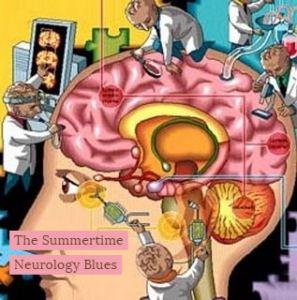 We hit the road last week for another trek to see the neurologist. We usually enjoy these long rides up into the heart of Arkansas, but it seems we can’t escape the unplanned detours lately. We headed out with our long list of questions and a feeling of excitement. The latest MRI results should be ready for viewing just in time for our visit.
We hit the road last week for another trek to see the neurologist. We usually enjoy these long rides up into the heart of Arkansas, but it seems we can’t escape the unplanned detours lately. We headed out with our long list of questions and a feeling of excitement. The latest MRI results should be ready for viewing just in time for our visit.
In our last neurology update, I mentioned while Gary receives excellent care from his neurology department they do use residents and medical students from the University of Arkansas Medical Center. Every visit we can look forward to explaining Superficial Siderosis in detail to a new group of wide-eyed young doctors. I will say it’s encouraging to see how engaged they are. Writing notes and paying considerable attention to every detail we tell them.
We began our visit detailing the changes Gary has been experiencing since his last follow-up.
His dysphagia seems to be in a holding pattern. His hearing, balance, and gait are noticeably worse. Falls are happening with higher frequency. Double vision used to be intermittent but now has progressed to most of the time. Gary finds if he is not paying attention saliva will sometimes escape and make a break for his chin. Walking on the treadmill brings on a headache and exhausts him more than usual if that’s even possible. His stutter has returned when he gets tired.
The subject of headaches brought up a discussion on why the GON block wasn’t working as well this time as it had previously. A possibility was since Gary wasn’t experiencing the same level of pain when he received this set of injections the pain clinic neurologist may have slightly missed the correct area. That seems reasonable. Never the less they have increased his Divalproex ER (Depakote) from 750mg to 1,500mg every evening. Gary has been on the increased dosage for six days now. While his headaches have improved, he has been barely able to get out of bed. I plan on contacting the neurology department to see if this might be a side effect of the dosage increase.
We moved on to the topic of blood pressure. Gary has been treated for hypertension for over 40 years, but over the past few months, he has been having episodes of low blood pressure readings in the 80/50 range, mostly in the mornings. We mentioned this to his PCP, his Electrophysiologist, and on his last trip into the ER for his DVT episode. Not once have we been able to have a healthcare provider document an event as it was happening. They made a note in his record, and we moved on.
Next up was our medical student
She performed a reflex test, sensory test, a finger-nose-finger test, checked his vision and his muscle strength. One area Gary has remained intact is muscle strength. He does experience severe cramping, but his muscles are not wasting. The little hammer-to-the knee test was interesting. Gary has shown extremely limited, or no lower limb reflexes the past few exams. She would tap and stare. Tap and stare. Tap and stare. Gary said later he felt no involuntary movement at all, but she insisted she saw something. So Gary’s reflexes have officially improved, at least for this visit.
This exam was the first time Gary has done poorly on the finger-nose-finger test so we can now add Dysmetria to his symptom list. (Look for a new addition to the general symptom list soon.) She decided to skip the Romberg test since Gary’s balance is terrible whether his eyes are open or closed.
The biggest disappointment this visit was finding out Gary’s hematologist had forgotten to order a set of brain MRI scans. The only ones taken were of his spine: cervical, lumbar and thoracic. I pulled up copies of his last brain scans on my phone, so the resident and medical student could see his hemosiderin. (Why of course I have copies on my phone, don’t you?) We decided since it wasn’t a usual hematologist order (MRI) his neurologist (in Little Rock, Ar) would contact the hematologist (in Shreveport, La) and coordinate a plan of care and testing schedule. Now we wait for a new MRI appointment.
This exam was going reasonably well, so we booked our next appointment and went on to the hotel. The following day we planned on heading home after breakfast. Gary had been feeling extremely unwell all morning. We delayed leaving so he could lay down for 30 minutes before we headed out for a three-hour drive. His blood pressure was back down to the 80/50 range, and Gary was feeling pressure in his chest area. After some hesitation, he decided we should leave as scheduled.
We made it to the city limits of Little Rock
The pressure in his chest was not relieving, and he still felt woozy. I turned the car around and headed to the emergency room. I have learned chest pain will take you to the front of the E.R. admission line every time. Triage went smoothly, and they took him straight back for an EKG. His blood pressure had returned to a reasonably healthy level again. Of course, it had.
The E.R. doctor and I had a spirited discussion about possible causes, and he decided a cardiology consult was needed. Five hours, an EKG, Chest x-ray, multiple blood tests and monitoring showed aside from the electrical problems Gary has, his heart it is in fact in good shape. The cardiologist contacted neurology, reviewed his exam results from the day before, and my descriptions of the events that had taken place over the last few months. He returned with an opinion; this was the result of autonomic peripheral neuropathy. The diagnosis: Orthostatic hypotension. Just another day in Superficial Siderosis paradise.
They sent us home with a few suggestions on living with this new diagnosis
First, Gary was told to discontinue his blood pressure medication immediately. We were told unless his blood pressure remained higher than 180/100 for five or more days not to take Lisinopril. Second, he was to increase his salt intake. For years we’ve been told reduce your salt. No more. Third, drink plenty of water. More than two quarts a day if possible. Fourth, wear compression socks. Fifth, and last, before he stands up from a sitting or reclining position to press his toes into the floor several times.
The cardiologist explained when your legs are affected by autonomic peripheral neuropathy the nerves do not contract the blood vessels to move blood flow from your lower extremities upward. That’s why Gary would always feel so dizzy. He also suggested rising slowly, no more jumping up, no problem there. If Gary felt light headed the best thing would be to lie down with his legs and feet elevated until it passed. It also means Gary is even more at risk for developing Deep Vein Thrombosis (DVT).
We at least have an answer now. That’s always preferable to being in the dark and worrying. We’re still disappointed about the MRI snafu, but for now, life goes on.

